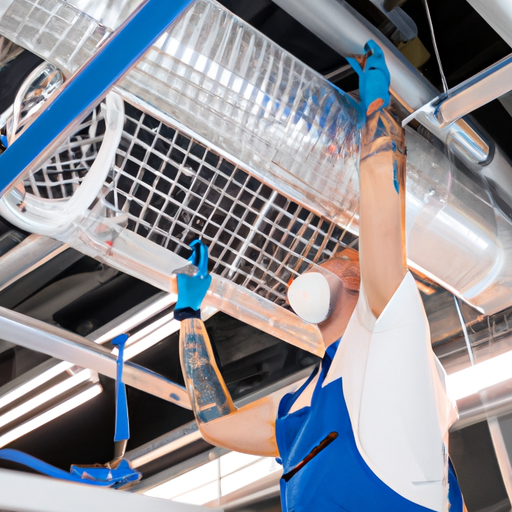This blog post explores the concept of air ducts, their functionality, and their importance in maintaining a healthy and comfortable living environment. It delves into the structure, operation, and maintenance of air ducts, providing a comprehensive understanding for both homeowners and professionals alike.
"What Exactly is an Air Duct?": An Introduction
Air ducts are an essential component of a building's heating, ventilation, and air conditioning (HVAC) system. They are responsible for distributing and circulating air throughout the building, ensuring a comfortable and healthy indoor environment. Air ducts are typically made of metal or flexible materials and are designed in a network of interconnected tubes that run behind walls, in ceilings, and under floors. These ducts act as passages for heated or cooled air to travel from the HVAC system to various rooms or areas within the building.
Air ducts play a crucial role in maintaining the desired temperature and air quality in a building. They work by moving air from the HVAC system's main unit to different rooms, where it is then dispersed through vents or grilles. This process ensures that every area of the building receives an equal amount of conditioned air, providing consistent comfort throughout. Additionally, air ducts also facilitate the removal of stale air and the introduction of fresh air, which helps maintain a healthy indoor environment.
It is important to note that air ducts are not only found in residential buildings but also in commercial spaces, such as offices, hospitals, and schools. The size and complexity of air duct systems can vary depending on the building's size, layout, and specific HVAC requirements. Proper design and installation of air ducts are critical to ensure efficient airflow and to avoid issues such as air leakage, which can result in energy waste and compromised indoor air quality.

A simple illustration of an air duct system in a home
"How does an Air Duct Operate?": The Mechanics Behind the System
Air ducts operate based on the principles of fluid dynamics and pressure differentials. The HVAC system's main unit, which includes the furnace or air conditioner, generates heated or cooled air. This conditioned air is then pushed by a blower or fan into the air ducts. As the air travels through the ducts, it encounters various components such as dampers, grilles, and registers, which help control and direct the airflow.
The air ducts are designed with specific dimensions and configurations to ensure efficient airflow. Smooth, straight ducts minimize air resistance, allowing the air to flow freely without unnecessary turbulence. However, bends, turns, and junctions in the duct system can create pressure drops and affect the overall performance.
To regulate the amount of air flowing into each room, dampers are strategically placed within the ducts. These adjustable plates or valves can be manually or automatically controlled to increase or decrease airflow. Grilles and registers, located at the end of the ducts, help distribute the conditioned air into the rooms while also allowing for air intake.
Air ducts also play a crucial role in maintaining the balance between supply and return air. Supply ducts carry the conditioned air from the HVAC system to the rooms, while return ducts collect the stale air and bring it back to the HVAC system for reconditioning. This process ensures the continuous circulation of air and helps maintain a consistent temperature throughout the building.
Proper insulation of the air ducts is essential to prevent energy loss and maintain the desired temperature. Insulation helps keep the air inside the ducts at the desired temperature, preventing unnecessary heat gain or loss. It also reduces the potential for condensation to form on the ducts' exterior, which can lead to moisture-related issues.
"Why is Air Duct Maintenance Necessary?": Exploring the Impact on Indoor Air Quality
Air duct maintenance is crucial for ensuring a healthy and comfortable indoor environment. Over time, air ducts can accumulate dust, debris, mold, and other pollutants. These contaminants can significantly impact indoor air quality, leading to a range of health issues and discomfort for occupants.
Regular air duct maintenance helps remove these accumulated pollutants and prevents them from being circulated throughout the building. This is particularly important for individuals with respiratory conditions such as allergies or asthma, as the presence of allergens and irritants in the air can trigger symptoms and exacerbate their condition.
In addition to improving indoor air quality, air duct maintenance also contributes to the overall efficiency of the HVAC system. When dust and debris build up in the ducts, it restricts airflow, forcing the system to work harder to heat or cool the space. This not only leads to increased energy consumption and higher utility bills but also puts unnecessary strain on the HVAC equipment, potentially shortening its lifespan.
Neglecting air duct maintenance can also lead to the growth of mold and bacteria within the ductwork. Moisture from condensation or leaks can create an ideal environment for mold to thrive. When the HVAC system circulates air through these contaminated ducts, it can spread mold spores throughout the building, posing a risk to the health of occupants.
By regularly inspecting and cleaning air ducts, these issues can be addressed proactively, ensuring cleaner air and optimal system performance. Professional duct cleaning services use specialized equipment to remove accumulated dust, debris, and microbial growth, improving both indoor air quality and the efficiency of the HVAC system.

A photo of a professional cleaning an air duct
"What are the Signs of a Malfunctioning Air Duct?": Identifying Common Issues
There are several signs to watch out for that indicate a malfunctioning air duct system. By being aware of these signs, you can take prompt action to address any issues and ensure the proper functioning of your HVAC system.
- 1. Poor Airflow:
One of the most common signs of a malfunctioning air duct is reduced or uneven airflow throughout your space. If you notice that certain rooms are not receiving adequate airflow or that your HVAC system is struggling to maintain consistent temperatures, it could indicate blockages or leaks in the ductwork. - 2. Unusual Noises:
Another sign of a malfunctioning air duct is the presence of strange noises coming from the system. If you hear rattling, banging, or whistling sounds when your HVAC system is running, it could be an indication of loose or disconnected ductwork. These noises can occur when air is forced through gaps or leaks in the ducts, causing vibrations and unusual sounds. - 3. Increased Energy Bills:
If you notice a sudden and significant increase in your energy bills without any corresponding change in your energy usage, it could be a sign of air duct issues. Leaky or poorly insulated ducts can lead to energy wastage as conditioned air escapes and unconditioned air infiltrates the system. This can result in your HVAC system working harder and longer to maintain the desired temperature, leading to higher energy consumption and increased utility costs.
Understanding the critical role air ducts play in maintaining indoor air quality and overall comfort is essential for homeowners and professionals. Regular maintenance and cleaning of the air ducts not only ensures optimum performance but also contributes to a healthier living environment. With the knowledge of what air ducts are, their functioning, and their maintenance, one can significantly improve their home or office's air quality.

